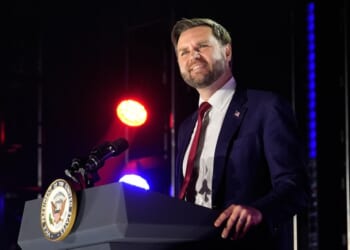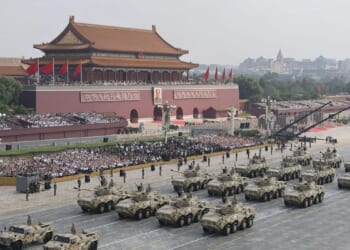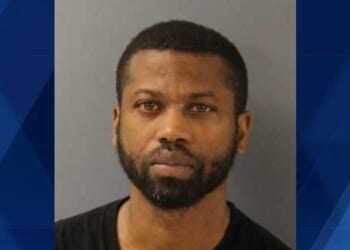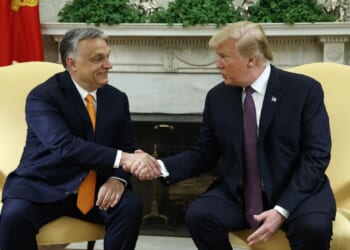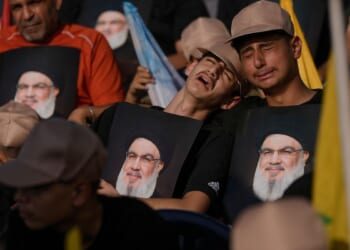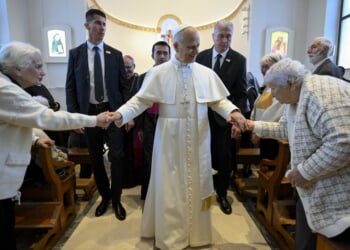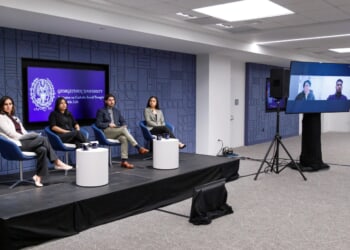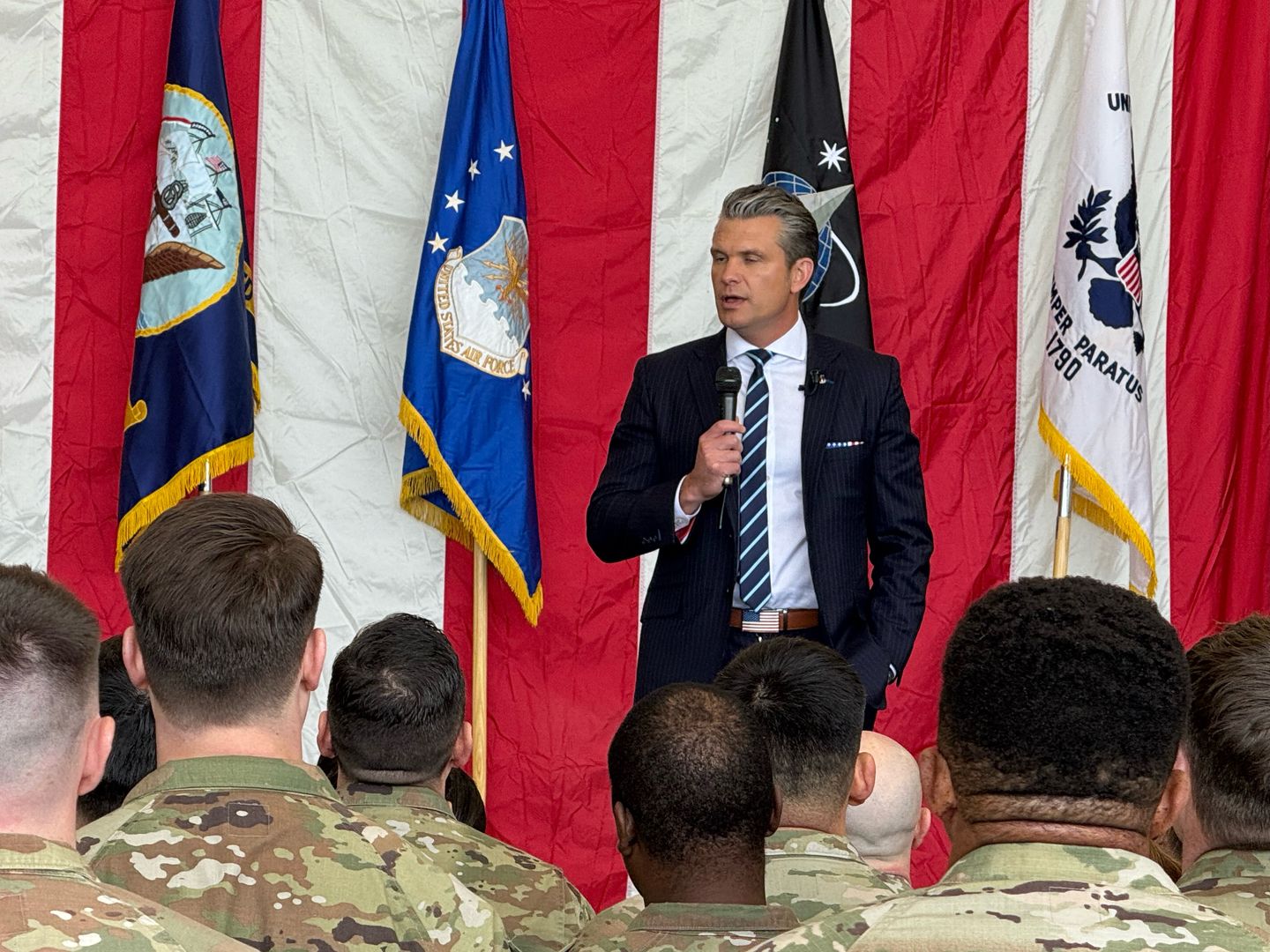
NEWS AND ANALYSIS:
Defense Secretary Pete Hegseth said he plans to meet with his Chinese counterpart, Defense Minister Adm. Dong Jun during a visit to Malaysia for a session of the Association of Southeast Asian Nations.
“As it is right now, we believe it will happen,” Mr. Hegseth said in an interview with Inside the Ring aboard an Air Force E-4B nuclear command post jet.
Dynamics and schedules could change and the meeting could be called off, he said.
The two defense chiefs held a good, frank and productive first talk during a video call in September.
“I think it’s always good to meet in person and keep lines of communication open,” Mr. Hegseth said.
Mr. Hegseth is attending a meeting of ASEAN defense ministers this week in Kuala Lumpur, Malaysia. A meeting with Adm. Dong on the sidelines would be one of the first high-level, in-person defense talks between U.S. and Chinese leaders in many months.
A senior defense official who briefed reporters on Mr. Hegseth’s four-nation visit to Asia said the Pentagon requested a meeting with Adm. Dong several weeks ago.
“We’re still waiting to hear back from the PLA,” the official said of the People’s Liberation Army. “This will be the first in-person meeting between the leaders. We’ll see if we’ll be able to make that happen.”
During the Sept. 9 video call the secretary told him that the U.S. was not seeking to change the communist regime in Beijing, nor is the U.S. seeking “strangulation,” the Pentagon said at the time.
“At the same time, however, [Mr. Hegseth] forthrightly relayed that the U.S. has vital interests in the Asia-Pacific, the priority theater, and will resolutely protect those interests,” the Pentagon said in a statement, noting further discussions were sought.
Adm. Dong, according to state media, told Mr. Hegseth that China favors open communication and seeks stable U.S.-China military relations that Beijing demands must be based on “equality, respect and peaceful coexistence” — diplomatic code for greater U.S. acceptance of the Chinese Communist Party and its military.
Adm. Dong also said any attempt to support “separatists” in Taiwan would be doomed to failure, the Xinhua News Agency said.
China cut off military exchanges and talks with the U.S. in 2022 to protest U.S. support for Taiwan.
Mr. Hegseth said earlier this year that the danger of conflict with China was real and imminent. U.S. forces in the region are being strengthened to deter a conflict in response, he said.
The threat posed by China is a major focus of Mr. Hegseth’s visit to the region, the senior defense official said. “The department continues to prioritize deterring China and the secretary asked the department to focus on reestablishing deterrence in the Indo-Pacific,” the official said.
“The threat that China poses will certainly be a major theme through all his engagements throughout the trip,” the official added.
On tension with China over Taiwan, the senior official said President Trump has made clear China will not invade Taiwan on his watch.
The Defense Department “serves as the sword and the shield of the president’s peace through strength agenda,” the official said, adding “we will continue to look for ways to strengthen deterrence throughout the region, including in the Taiwan Strait.”
Asked about reports that a forthcoming national defense strategy calls for shifting the central U.S. security focus away from China and toward the Western Hemisphere, the official said Mr. Hegseth has made clear that the Indo-Pacific remains a priority theater.
The U.S. is capable of both protecting the homeland and deterring an increasingly aggressive China, the official said.
Mr. Hegseth “has asked the department to prioritize deterring China. That was his guidance from the beginning, and that guidance has not changed,” the official said.
“Defending the homeland is an important priority of the department. It is an obligation we owe to the American people. Doing one does not detract from the other,” the official said.
Defense chief to visit Korean DMZ
Mr. Hegseth will travel to the Demilitarized Zone separating North and South Korea next week along with meeting with his South Korean counterpart and U.S. military leaders.
Mr. Hegseth also is scheduled to meet with South Korean President Lee Jae-myung during the visit set to begin Monday. It will be the secretary’s first visit to South Korea since becoming the senior Pentagon leader.
The DMZ visit will include travel to the Joint Security Area with South Korean Defense Minister Ahn Gyu-back.
The visit will mark the first by a defense secretary since 2017 when then-Defense Secretary James Mattis traveled to the DMZ.
The Joint Security Area is where both South Korea and North Korean troops are located and have held talks before.
A few North Korean soldiers have defected to South Korea across the heavily fortified and mined areas on either side of the area.
The most recent case involved a North Korean soldier who ran across the border Oct. 19, the South Korean military said. The soldier was taken into custody after crossing the land border, the South Korean military said in a statement, noting that the soldier sought to resettle in South Korea.
It was the first defection since August 2024.
The DMZ is a 155-mile long border armed with land mines, tank traps, barbed wire fences and combat troops.
A second senior defense official said relations between North and South Korea remain troubled despite attempts by the liberal Lee administration to reach out to Pyongyang.
“There’s not much receptivity in Pyongyang to the outreach and the efforts to try to reengage with the still relatively new ROK administration,” the second official said.
“North Korea has signaled at least some willingness to reengage with the U.S. but it’s conditional and so whether or not those conditions will be sufficient, your guess is as good as mine,” the official said.
President Trump, who is visiting South Korea for a meeting with Chinese President Xi Jinping, has said he was willing to meet with North Korean leader Kim Jong-un.
But the lack of response from North Korea for the meeting, like the one at the DMZ in 2019, suggests the prospects are dim.
North Korea on Tuesday responded to Mr. Trump’s request for a summit with firing missiles off the western coast, state media reported.
Mr. Hegseth in South Korea also plans to meet with some of the 28,000 American troops based there.
During his meetings with South Korean and U.S. military and defense leaders, Mr. Hegseth will discuss giving the South Korean military operational control over forces in war time, the senior defense official said.
“The department has had extensive discussions with the [Republic of Korea] and with our ROK counterparts, on how South Korea can assume primary responsibility for the alliance’s conventional defense against [North Korea],” the official said.
The official said South Korea’s desire to control all military forces during a war is a priority of Mr. Lee, and Mr. Hegseth expects to discuss the issue when he meets Mr. Ahn, the defense minister.
Mr. Hegseth is expected to announce an expansion of defense industrial cooperation between the U.S. and South Korea during the visit.
North Korea’s hypersonic missile capability questioned
U.S. intelligence agencies are casting doubt on North Korea’s recent claims to building ultra high-speed maneuvering missiles, a senior defense official said.
North Korean state media said the military recently tested what was called a hypersonic glide vehicle — a boosted armed glider capable of maneuvering to avoid detection and attack by anti-missile systems.
The announced hypersonic test followed the recent deployment by the U.S. military in South Korea of an advanced air defense system called the Indirect Fire Protection Capability system.
The system is capable of attacking some North Korean missiles.
“I don’t think there’s any evidence that they’ve mastered hypersonics yet,” the senior official said. “That is technically way different than what they have demonstrated with their previous missile launches.”
However, the official said the North Korean military is “clearly working on hypersonics.”
While claiming that hypersonic technology is incorporated into previous missile tests. “They’re working on it, but not there yet,” the official said.
North Korea is building several long-range missiles that U.S. officials say are capable of landing a nuclear warhead on the U.S.
The missile development program includes what the official described as a multiyear comprehensive program to “build out” the effectiveness, accuracy and technical sophistication of all its missile forces.
Pyongyang is motivated by the buildup based on perceptions that the West “is out to get them and do regime change,” the official said.
The recent claims of having hypersonic missile capabilities are “a fairly typical example of a little bit of North Korean overstatement and overclaim, with just a hint of reality within the test itself,” the official said.
Other intelligence on North Korea suggests there are improvements in developing technology to protect nuclear warheads from burning up during reentry into the atmosphere on the way to targets.
“I think it’s fair to say that they are making progress, but they have not yet demonstrated full missile performance through all phases of flight, including through reentry, in any substantive way that they are likely to have great confidence that their ICBM missiles and reentry vehicles would perform as designed in the event of a crisis,” the official said.
North Korea’s recent mutual defense agreement with Russia also includes Pyongyang acquiring space launch technology from Russia, the official said. The know-how likely will be used in North Korean missiles because space launch and ICBM technology are similar.
“We haven’t seen it demonstrated yet, in part because North Korea hasn’t done either an ICBM or an [space launch vehicle] test in a while now, but I think we should all watch very closely the next one,” the official said.
“And there will be a next one. It’s inevitable. And we’ll see whether it shows any substantial improvement over previous efforts.”
Asked whether North Korea will soon conduct another underground nuclear test, the official said the North Koreans have already done six tests — enough to have operational nuclear capabilities.
If a new test is carried out, it likely will be done as part of the work on a lower yield theater nuclear warhead applicable for use in regional conflicts, the official said.
The first six nuclear tests were progressively larger in blast size from simple fission explosions to a thermonuclear detonation.
“This would be an intentional step back for probably a smaller weapon design to give more operational flexibility for theater level strike as opposed to intercontinental or strategic strike, which is likely where the design of the warheads has progressed through testing to date,” the official said.
A new test of a small warhead would be used to validate different design and performance capabilities for a different category of nuclear weapon.
• Contact Bill Gertz on X @BillGertz.

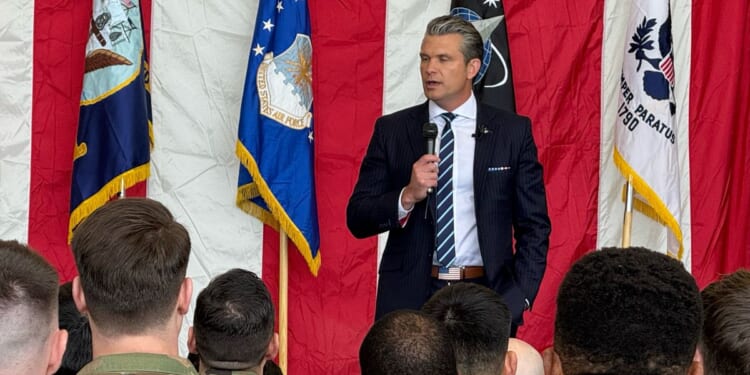
![Scott Bessent Explains The Big Picture Everyone is Missing During the Shutdown [WATCH]](https://www.right2024.com/wp-content/uploads/2025/11/Scott-Bessent-Explains-The-Big-Picture-Everyone-is-Missing-During-350x250.jpg)
